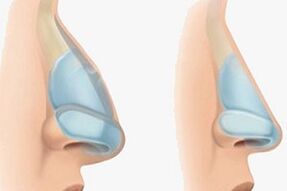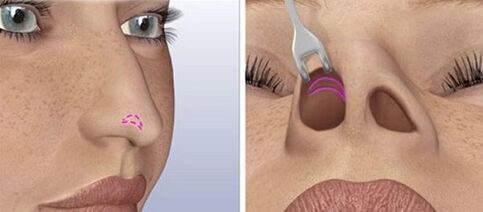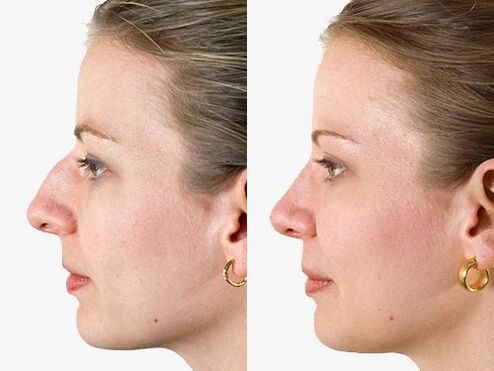
What is rhinoplasty or nasal surgery?
It is one of the most widespread and ancient plastic surgeries in the world (first performed in 1000 BC).
It represents part of the entire reconstruction process, which combines methods of surgical correction of the shape and size of the nose by replacing congenital or acquired defects in this part of the face with bone and cartilage tissue taken from the patient.
Rhinoplasty changes the patient and is considered one of the most effective ways to change the appearance.
Types and indicators for
The nose is a olfactory organ with a very complex anatomical structure. Surgical repair of this part of the body is one of the most difficult plastic surgeries in the world, because the doctor must not only change the appearance, but also maintain its functionality (in some cases, such a procedure causes curvature of the osteochondral septum, difficulty breathing or loss of smell). Therefore, surgeons advise their clients to think carefully before doing this and answer the question of whether rhinoplasty is worthwhile (except in cases where the irregular shape of the nose causes respiratory disorders and can lead to oxygen starvation of the brain). The optimal age for conducting a conductor is 20-30 years, but earlier if there is a respiratory problem or after severe physical injury.
Key indicators:
- disproportionate size of the respiratory tract relative to the whole face;
- hypertrophy of turbines;
- injuries or deformations in the bone or cartilage tissue in the area of the osteochondral septum, curvature;
- asymmetrical, forked or very raised nose tip;
- "Donqar";
- respiratory failure or difficulty;
- dissatisfaction with the results of previous plastics.
There are several types of rhinoplasty, which are classified depending on the purpose and technique of the procedure:
- nose tip plastic - a method of surgical correction of the shape or removal of asymmetry (bifurcation) of the tip of the nose;
- grafting (autotransplantation) - during the procedure, the doctor enlarges and lengthens a very large nose by transferring cartilage tissue taken from the ear area;
- reduction - a method of surgical intervention aimed at correcting the shape and size of the turbines;
- rear alignment - removal of the hump behind the nose;
- septoplasty - a surgical method to correct a deviated nasal septum;
- magnification - a surgical method to correct the shape of the bridge of the nose to eliminate the effect of "correction";
- Non-surgical rhinoplasty - surgical correction of the shape, size and proportions of the nose (nasal contour plasticity), the use of hormonal resorption drugs that destroy the bone and cartilage tissue in the nasal septum, or Aptos threads (lifting the wings and tip of the nose).
How are you preparing for the operation?
Before the procedure, the patient should visit a plastic surgeon who will measure the respiratory system, determine the amount of work to be done, simulate the expected outcome of the operation on a computer using a special program (computer modeling helps the doctor to better understand the client's wishes) and for the following testsWrite a post:
- general and clinical blood test;
- electrocardiogram (with decoding);
- fluorography;
- Testing for AIDS, HIV or hepatitis;
- tomography of the paranasal sinuses.
You should not smoke or take blood thinners for two weeks before the procedure. No food or drink is taken 12 hours before the operation (a light meal is allowed the night before).
Before the procedure, doctors recommend a good rest and sleep (this will help calm the nervous system).
Technique depending on the method
Immediately before the procedure, the client signs a contract with the plastic surgery clinic, indicating the consent to the operation, the cost and type of operation, the name and surname of the anesthesiologist and plastic surgeon, and the patient's whereabouts. those who are familiar with the development of postoperative complications and their methods. The person is then taken to the operating room, the face is cleansed with lotion, the piercing is removed (if any) and, if necessary, pre-operative marking is done with a special marker. The operation is performed under general intravenous or endotracheal anesthesia and lasts 1-2 hours.
There are two methods of rhinoplasty: open and closed.
Open rhinoplasty
Open rhinoplasty is a procedure in which a doctor makes an incision in the columella (the part of the skin between the nostrils), corrects the shape of the nasal structures, and finally places a few cosmetic stitches on the skin. This surgical method is used to correct serious damage and deformations of the nasal cavity, to reconstruct bone and cartilage tissue by autograph.

Closed rhinoplasty
Closed rhinoplasty is a procedure in which the surgeon makes an incision in the nasal cavity, separates the soft tissues from the osteochondral frame, performs a series of surgeries to change the shape of the nose, and then sutures the mucous membrane with a suture. material. A less traumatic method of plastic surgery, after which complications rarely occur and scars remain.

Doctors perform a second (secondary) rhinoplasty after an unsuccessful first operation or if there is an unsuitable result for the client. This is a more general (technical) procedure that requires certain skills and practical experience from the surgeon, is performed under general anesthesia, and requires the same preparation as the primary plastic. Not earlier than a year after the previous surgery.
Recovery time and results
The rehabilitation period lasts 3-4 weeks, but the patient spends one day in the hospital. Immediately after the operation, a tampon is inserted into each nostril, the surgeon removes it after three days, and a plaster cast is applied to the nose (removed after ten days). After removing the tampons, the doctor prescribes drops to the patient to eliminate postoperative edema and accelerate the healing of soft tissues. Swelling and bruising disappear completely after 1, 5-2 months. The initial result is evaluated after 6-8 months, the final result - after 12. Wounds appear after the first three months after rhinoplasty, and then almost do not appear.
Postoperative recommendations:
- you should sleep on your back for two weeks after surgery;
- for the first few weeks you can't visit the sauna, swimming pool, solarium, gym and do hard physical work;
- you can only eat hot food and drink hot drinks until the postoperative wounds are completely healed;
- Do not wear glasses for 2-3 months after the procedure;
- you should not smoke during the entire recovery period.
Consequences of rhinoplasty or nasal surgery: before and after photos


Possible complications and contraindications
Contraindications to surgery:
- oncology;
- Runny nose;
- influenza, SARS;
- active herpes;
- diabetes;
- atrophic rhinitis;
- infectious diseases of the oral cavity;
- mental disorders;
- tuberculosis;
- heart and kidney diseases.
Rhinoplasty is called one of the most difficult plastic surgeries in the world, during which the surgeon removes several cosmetic defects at once, not once, and is therefore associated with the development of a number of possible complications:
- nosebleeds;
- postoperative pigmentation;
- soft tissue swelling and hematoma;
- odor loss;
- appearance of keloid scars;
- difficulty breathing;
- curvature of the nasal septum.
What operations can be combined?
Often, nasal plastic surgery is combined with septoplasty - surgical correction of the nasal septum (sometimes called septorinoplasty), cheiloplasty (change in the shape and volume of the lips) and mammoplasty - plastic surgery aimed at correcting the shape and size. breast (in the latter case, the operation involves two doctors, one performing rhinoplasty, the other breast plastic surgery).
Estimated prices for rhinoplasty (nose surgery)
The plastic surgeon provides accurate information on how much the nose surgery will cost. The cost of rhinoplasty includes pre-consultation, hospital stay, computer simulation of the results, removal of tampons and removal of the bandage. The cost of the procedure depends on the type and method of surgery.
Rhinoplasty is an operation that is equally popular among women and men. Helps people get rid of health problems, improve appearance and facial proportions.




















